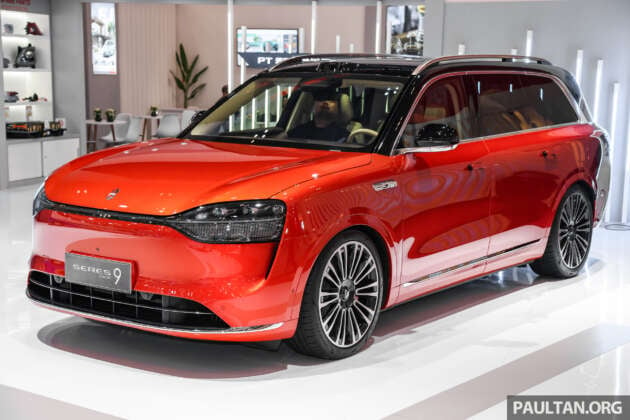As expected, there’s no shortage of Chinese brands at the Gaikindo Indonesia International Auto Show (GIIAS) this year, and one of them is Seres, which has the Aito M9 as one of its exhibit vehicles.
The large luxury SUV isn’t on sale yet in the republic, but has been brought in as a “concept” to gauge consumer acceptance in the country. However, Sokonindo Automobile, a joint venture between Sokon Group and Kaisar Motorindo Industri, indicated a couple of months ago it was planning to introduce the M9 along with its M7 sibling in the country next year.
When it arrives, it will not be marketed as the Aito (which is a joint-venture brand between Huawei and Seres), but will instead be known as the Seres M9. Sounds a little confusing? Not really, as the short of it is that the Huawei Aito M9 and this is the same car.
In its domestic market, the M9 is available as a full-fledged EV or as a range-extender EV (REEV)., in two variant forms for each. The display example at GIIAS is the range-extender version, but the product literature at the show also highlights the BEV, so both variants are likely to be sold in Indonesia.
The REEV (or EREV, extended range electric vehicle, as the company calls it) features a 1.5 litre four-cylinder petrol engine that acts as a generator for the ternary lithium battery that comes in 42 or 52 kWh energy capacities. The battery powers two electric motors, a 224 PS (221 hp or 165 kW) and 315 Nm unit at the front, and a 272 PS (268 hp or 200 kW) and 360 Nm rear unit.
Performance figures include a 0-100 km/h time of 4.9 seconds and a top speed of 200 km/h, and as for operational capability, the claim is that the REEV offers up to 1,210 km (42 kWh battery) or 1,239 km (52 kWh battery) of WLTC-rated range on a full tank. Without relying on the range extender, the fully electric driving range is 190 km (42 kWh battery) or 233 km (52 kWh battery), WLTC-rated.
As for charging, it takes about five hours (7 kW) or three hours (11 kW) to get the battery on the range extender from a 20-90% SoC via the AC route, while DC fast charging takes about 30 mins to gte the unit from a 20-80% SoC, although no charging capacity figures were indicated.
As for the BEV, it also features a dual-motor, all-wheel drive setup, although the output from the electric motors is different. The one at the front is rated at 218 PS (215 hp or 160 kW) and 277 Nm, while the rear motor provides 313 PS (308 hp or 230 kW) and 396 Nm. The top speed is identical to the range extender, although the century sprint time is lower at 4.3 seconds.
A 100 kWh ternary lithium battery provides a CLTC-rated range of up to 630 km on a single charge. It takes 11.7 hours (7 kW) and 7.5 hours (11 kW) to get the unit from a 20 to 90% SoC via AC, and DC fast charging from 30-80% takes just 15 minutes.
No shortage of tech and novelties amidst all that presented luxe, and these include a panoramic glass roof and soft-close doors to a multitude of screens at the front, with a 12.3-inch digital instrument cluster, a 15.6-inch central infotainment touchscreen and a 16-inch front passenger touchscreen to be found. Elsewhere, there’s a retractable 32-inch screen and an actual laser projector for rear occupants.
Looking to sell your car? Sell it with Carro.
Content Disclaimer and Copyright Notice
Content Disclaimer
The content provided on this website is sourced from various RSS feeds and other publicly available sources. We strive to ensure the accuracy and reliability of the information, and we always provide source links to the original content. However, we are not responsible for the content’s accuracy or any changes made to the original sources after the information is aggregated on our site.
Fair Use and Copyright Notice
This website may contain copyrighted material, the use of which has not always been specifically authorized by the copyright owner. We believe this constitutes a “fair use” of any such copyrighted material as provided for in section 107 of the US Copyright Law.
In accordance with Title 17 U.S.C. Section 107, the material on this site is distributed without profit to those who have expressed a prior interest in receiving the included information for research and educational purposes. If you wish to use copyrighted material from this site for purposes of your own that go beyond fair use, you must obtain permission from the copyright owner.




